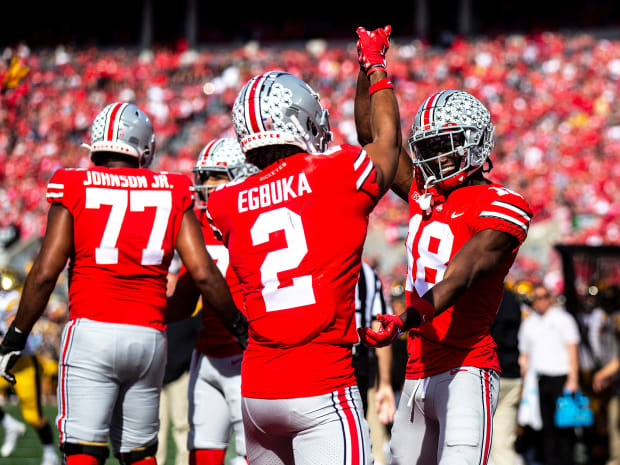A 12-team field would bring fundamental changes that fans will have to prepare for.
Forty names, games, teams and minutiae making news in college football (onside kick onions sold separately in Eugene):
MORE DASH: Congrats, You’re Stuck | Rising Coordinators
Second Quarter
The Pros and Cons of the Expanded Playoff Calendar
As colleague Ross Dellenger reported last week, the College Football Playoff folks are busy working to rearrange the schedule to make a 12-team postseason tournament (11) happen as soon as possible. The Dash has long been a fan of that 12-team model, which is scheduled to take effect in 2026 but might be rush-ordered into existence in ’24 or ’25.
If the new Playoff can be pulled off that soon, it won’t look exactly like the more permanent model unveiled in 2026. But either way, there will be some fundamental changes to the calendar that fans will have to prepare for. The Dash looks at a brief list of pros and cons.
The overriding pro: a better postseason, more access to the championship, a wider net of contenders, more games with Playoff implications. It would nationalize a Playoff that has become increasingly regionalized, with 17 out of 32 bids having gone to teams from the South. Teams from that area may still dominate the final matchup (13 of the last 14 championship game participants have been from the South), but the excitement of playoff competition will be more diffuse.
That’s the fundamental underpinning of a bigger Playoff—it’s a good thing for more interested parties. Southeastern Conference commissioner Greg Sankey, when faced with expansion intransigence from his fellow CFP leaders, rightly pointed out that his league would still do just fine with a four-team model. But for everyone else, this is better.
But progress does not come without side effects, and the Dandy Dozen model will have several.

Jeff Hanisch/USA TODAY Sports
More August football (12). It’s highly likely that, come 2026, the putative “Week Zero” will become “Week 1,” and almost every team will start play the last weekend of August instead of Labor Day weekend. This isn’t a terrible development, and it pretty much has to happen to create any breathing room at the back end of the season. But it does present some challenges:
More games played in punitively hot weather, which could be a player health issue in addition to negatively impacting attendance in some locales.
More games played before the general student body is on campus, which also could reduce attendance (and home field advantage).
More games potentially impacted by severe weather.
A further lengthening of the regular season—and reducing off summer downtime—for the players, coaches and support staff. The current expectation is that everyone associated with a football program forfeit time at home to be on campus nearly all summer for workouts, and in theory this would add another week to the preseason grind.
More bad games. A lot of teams aren’t ready to play quality football in August; remember Nebraska-Northwestern this season? (Although, in retrospect, those are two teams that haven’t played much quality football since then, either.)
Watch college football live with fuboTV: Start a free trial today!
Moving rivalry games off Thanksgiving weekend (13). In moving up the start of the season, the big games traditionally seen on the holiday week that is most tied to football would be shuffled forward as well. Then conference championship games would be played Thanksgiving week. This is a blow to tradition—which, frankly, has been the most disposable commodity in the sport in recent years.
Get ready for the Iron Bowl, Egg Bowl and so many other in-state rivalry games to be played on the third week of November instead of the fourth. Get ready for Ohio State–Michigan and many of the Big Ten trophy games to be contested then as well. Same with the Apple Cup, Civil War, Notre Dame at USC, the ACC-SEC rivalries and so forth. That will take some getting used to.
In theory, at least, this might help student attendance at those games. A lot of them go home for Thanksgiving break and wind up watching those rivalries on TV instead of in person. If they’re played five days before Thanksgiving instead of two days afterward, that could put more students in the stands.
Greater conflict with the NFL (14). The presumptive start to the Playoff—four first-round games played on campuses, which will be awesome—is the third weekend of December. That’s when the NFL starts moving a smattering of games each week onto Saturdays. TV ratings show who wins when the college game goes head-to-head with the pros—The Shield is undefeated.
That has led to some theorizing about finding noncompeting broadcast windows on that weekend. One potentially palatable alternative: one game Thursday, one Friday and two Saturday, the latter two in competition with the NFL. Or one Friday and three Saturday. Either would work.
There would be no presumed conflict with the quarterfinals, which would be anchored around New Year’s Day—as it should be. That’s one day that college football should not just cling to, but return to prominence after lessening its role in recent years.
As for the semifinals? Those would be butting heads with the NFL wild-card weekend, which might make Thursday- and Friday-night options the most attractive.
College leaders did some anonymous chafing last week about the NFL big-footing them on broadcast windows. The complaint about the NFL’s recently announced addition of a Black Friday game the day after Thanksgiving is valid. But an expanded CFP competing with the NFL in late December and in January is a fight the college game picked, not the other way around.
The Playoff bleeding into the academic spring semester (15). Here’s a quaint notion—what about the academic impact on players competing into the latter half of January? A quick check of this year’s academic calendar for the current top five teams shows a lot of potential conflict.
Playoff semifinals contested 10 to 12 days into January and a championship game played a week or more after that would create academic issues for Georgia, Alabama, Ohio State, Michigan and Clemson players. Michigan starts spring semester classes Jan. 4, Georgia and Ohio State on Jan. 9, Alabama and Clemson on Jan. 11.
Sure, other college sports deal with travel and competition schedules impacting classes at that time of year as well. But Playoff semifinals and finals assuredly would not come with the quick-in, quick-out travel plans of, say, basketball. Acclimation, practice and media obligations would require being on-site at least two days ahead of the game, if not three. The day after the game would be lost to travel. Depending when the games are played, players could be looking at starting a new semester by missing an entire week of in-person class.
As currently envisioned, the Playoff schedule does make room for fall-semester finals—a critical concession to the alleged reason the players are in college to begin with. But the start of the spring semester likely is going to be rocky for a few teams.
Further conflict with the December signing period (16). The Dash would very happily shoot the December signing period into the sun. This would alleviate a lot of problems, most notably the in-season acceleration of the coaching hire-and-fire cycle and the number of coaches abandoning their teams before bowl games. But until the national letter of intent signing period is changed—to March or April, ideally—that’s one more complication to deal with during the Playoff.
Trying to shepherd a high-end recruiting class to signing day while simultaneously prepping for and competing in a first-round Playoff game? Even the notoriously unsympathetic Dash would feel for coaches trying to balance those two massive tasks.

Joseph Cress/Iowa City Press-Citizen/USA TODAY Network
Four for the Playoff
Each week, The Dash hands down the College Football Playoff bracket on stone tablets. Here’s the current lineup, if today were Selection Sunday:
Peach Bowl: top-seed Tennessee (17) vs. fourth-seed Ohio State (18).
The Volunteers (7–0) scheduled well, slotting FCS team Tennessee-Martin the week after the showdown with Alabama. Tennessee did its thing offensively, racking up 65 points and nearly 700 yards against an outmanned opponent. Next up for the Vols: hosting Kentucky, which is coming off an open date, Saturday in a game that will not be easy.
The Buckeyes (7–0) have seen their résumé flatten out after playing a succession of disappointing teams. What looked like big games before the season started have failed to deliver—Notre Dame is 4–3, Wisconsin is 4–4, Michigan State is 3–4, Iowa is 3–4. That said, Ohio State continues to pass the eye test with flying colors. Next up for the Bucks: at Penn State Saturday in what will be their toughest road test to date by far.
Fiesta Bowl: second-seed Georgia (19) vs. third-seed Michigan (20).
The Bulldogs (7–0) had their traditional off week before the Cocktail Party but still saw their résumé enhanced. Teams they blew out scored noteworthy wins: Oregon over UCLA, South Carolina over Texas A&M. There are challenges ahead but little indication that Georgia isn’t capable of rising to meet them. Next up for the Dogs: Florida in Jacksonville in a rivalry game Georgia has dominated over the previous five years.
The Wolverines (7–0) also had an open date after a strong seven-week start. The blowout of Penn State gained some currency when the Nittany Lions disposed of Minnesota easily. Michigan is taking care of the ball better than anyone in the Big Ten (just four turnovers so far) but also lacking in takeaways (seven, three fewer than anyone else in the league). Next up for the Wolverines: Michigan State on Saturday, as they try to end a two-game losing streak to their in-state rivals.
Dropped out: none.
Also considered: TCU, Clemson, Alabama, Oregon.
MORE DASH: Congrats, You’re Stuck | Rising Coordinators